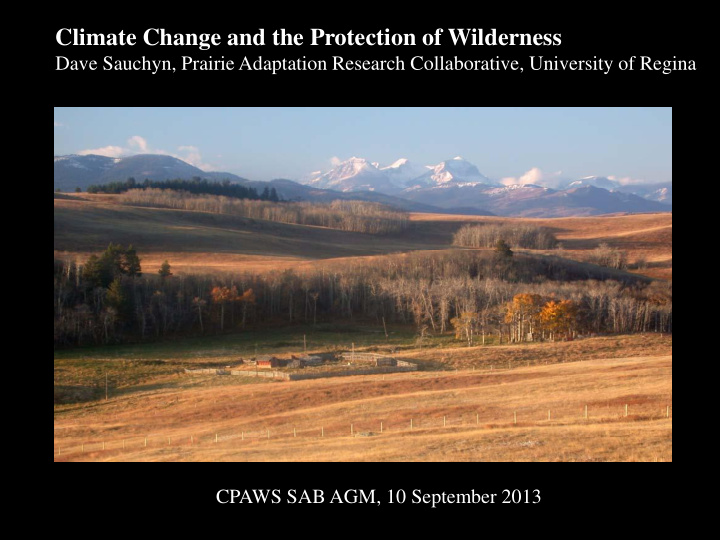



Climate Change and the Protection of Wilderness Dave Sauchyn, Prairie Adaptation Research Collaborative, University of Regina CPAWS SAB AGM, 10 September 2013
University of Regina PARC Tree-Ring Lab Network
Mean annual flow (m 3 /s), Bow River at Calgary, 1107-2007
Cycles in the tree rings
Mean Annual Flow (m 3 sec -1 ), Bow River at Calgary 1911-2010
We are losing the advantage of a cold winter
Mean Snow Depth, 1979-96 Brown et al. 2003; www.ccin.ca/cms/en/socc/snow/snowAtlas.aspx
July 2013 was the 341st consecutive month (more than 28 years) with a global temperature above the 20th century average. Every month has been warmer than average since May, 1985.
Mean Annual Temperature ( ° C), Calgary, 1885-2010
Climate is the statistics past of weather future Therefore climate change is a shift in the statistics: the average and/or the variability Source: IPCC
Hogg and Hurdle , 1995
Munich Reinsurance (2012) Severe weather in North America
Vulnerability and Adaptation to Climate Extremes in the Americas (VACEA) Vulnerabilidad y Adaptación a los Extremos Climáticos en las Américas Principal Investigators: Los investigadores principales Dr. Dave Sauchyn, University of Regina, Canada Dr. Fernando Santibañez, Universidad de Chile, Santiago www.parc.ca/vacea/
Source: Kienzle 2011
Research Sites (Watersheds)
Study “Communities”
Community Vulnerability Assessment – 170 Interviews
VACEA - Objective The overall objective is to improve the understanding of the vulnerability of rural agricultural and indigenous communities to shifts in climate variability and to the frequency and intensity of extreme climate events, and to engage governance institutions in Canada, Argentina, Brazil, Chile and Colombia in enhancing their adaptive capacity to reduce rural community vulnerability.
Increasing the resilience of natural systems is a standard goal of conservation ; intact ecosystems have more resources for withstanding stresses. B U Y I N G T I M E : A User’s Manual for Building Resistance and Resilience to Climate Change in Natural Systems (WWF 2003)
1. PROTECT ADEQUATE AND APPROPRIATE SPACE Ecosystems with high biodiversity and those that maintain crucial structural components are thought to recover more easily from climatic disturbances. Traditional conservation methods such as creating protected areas will thus have another justification in the next several decades. … Planning reserves will now require an eye for potentially dramatic future changes in protected areas; thinking about not only current but future configurations of habitats, communities, and ecosystems. 2. LIMIT ALL NON-CLIMATE STRESSES To support ecosystem resilience you must reduce the number of simultaneous insults faced by that ecosystem. [Climate change tends to amplify adverse impacts of other stressors.]
3. USE ACTIVE ADAPTIVE MANAGEMENT AND STRATEGY TESTING Given uncertainty about the exact nature of ecosystem impacts of and responses to climate change, effective management will require a responsive and flexible approach. … In instances where impacts are relatively clear, active intervention to increase adaptive capacity coupled with monitoring is necessary. Such intervention may include assisted migration or reintroduction of species , non-chemical control of pest or disease outbreaks, prescribed burning or other fire management strategies, … controlling invasive species and decreasing nutrient-enhanced run- off … OR … Let Nature Take its Course?
Does the Anthropocene deserve formal recognition as a subdivision of the Quaternary? Alexander Wolfe, Professor of Earth and Atmospheric Sciences, University of Alberta CANQUA Biennial Conference, August 22, 2013, Edmonton Abstract: A strong case can be made that the Anthropocene concept … deserves formal recognition as a new subdivision of geological time within the Quaternary. While globally expressed stratigraphic fingerprints of the Anthropocene begin to appear in the geological record soon after the Industrial Revolution, they accelerate markedly in the latter half of the 20th century. This is precisely when humanity’s collective influence becomes prominent through enhancement of the greenhouse effect, and other key biogeochemical cycles, become more firmly modulated by humans than the sum of natural processes.
Holtgrieve et al. (2011) A Coherent Signature of Anthropogenic Nitrogen Deposition to Remote Watersheds of the Northern Hemisphere
Atmospheric Carbon Dioxide Source: NASA <climate.nasa.gov/evidence>
The level of the most important heat-trapping gas in the atmosphere, carbon dioxide, has passed a long-feared milestone , scientists reported Friday, reaching a concentration not seen on the Earth for millions of years . Scientific monitors reported that the gas had reached an average daily level that surpassed 400 parts per million – just an odometer moment in one sense, but also a sobering reminder that decades of efforts to bring human- produced emissions under control are faltering.
Major ecological changes are expected
Recommend
More recommend